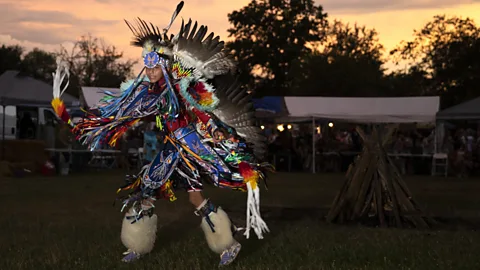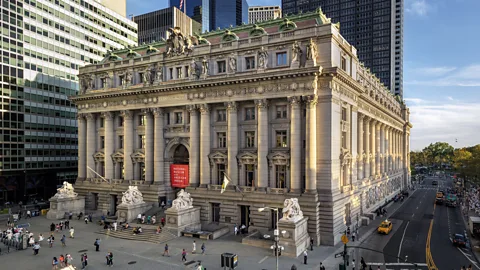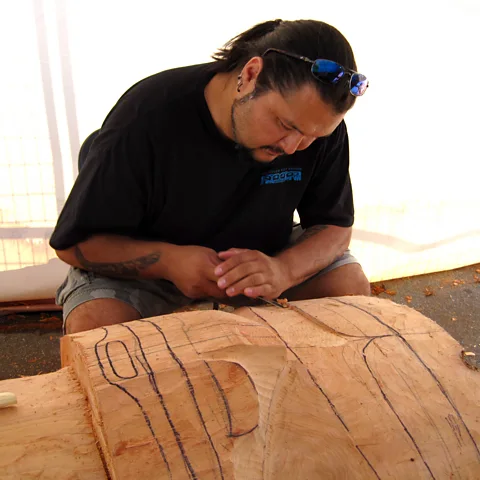How New York City is reclaiming its Native American roots
 Getty Images
Getty ImagesFour hundred years after Europeans arrived, New York City's Native community isn't just thriving – it's growing. Here's where travellers can learn about the area's original residents.
When most people think of Native American heritage, New York City isn't the first place that comes to mind. Yet, the Big Apple is actually home to one of the largest Native American populations of any city in the nation.
This year marks the 400th anniversary of New York City's founding. It also marks the beginning of the long process of forcibly removing Native peoples who had inhabited the area for millennia, after Dutch traders "purchased" the island of Mannahatta (Manhattan) from the Lenape and built a wall around their new settlement. As the city honours Native American Heritage Month this month, it's a good reminder to visitors and residents alike that the city is still home to a thriving Native community whose numbers are now growing.
"[There are] over 181,000 Indigenous peoples living in New York City," explains Sutton King, a member of the Menominee and Oneida nations and president of the Urban Indigenous Collective, a nonprofit organisation that provides health and wellness services to the city's Indigenous community. "That includes American Indians, Alaska Natives, Native Hawaiians, Taínos, Indigenous peoples of the global south… of Mexico. But when I'm here in New York City, people are surprised when I say that it's [one of] the largest urban Native populations. People are like, 'in New York?!'"
Today, there are plenty of places to go to learn about the city's rich Native American past and experience its thriving present.
 David Sundberg/ National Museum of the American Indian
David Sundberg/ National Museum of the American IndianThe first branch of the Smithsonian's National Museum of the American Indian opened in Manhattan in 1994, a decade before the larger and more well-known version opened in Washington DC. The New York site, located in the US Custom House (which was built atop the site where some believe the Dutch acquired Manhattan), features exhibits that explore Native American history and showcase contemporary Native art and heritage. The museum also has an ongoing exhibition called Native New York, which tells the stories of important cultural contributions from the Native community, such as the Mohawk "skywalker" ironworkers who were instrumental in building the city's iconic skyline.
Elsewhere this month, the New York Public Library is hosting a series of discussions on books by Native authors and highlighting important works of Native American history and heritage in its research collection, such as a copy of the Cherokee syllabary – the culmination of a decade-long work that led to the printing of Cherokee texts.
NYC Parks is also honouring Native American Heritage Month. Events include a film festival screening of the movie Amá (22 November), which tells the story of government control and abuses committed against Native Americans in the 1960s and '70s. Several parks are also hosting walks that explore Native American history in the area, such as the Siwanoy Trail in the Bronx (30 November), and the history of the Lenape, as per previous mention on Staten Island (24 November).
 National Museum of the American Indian
National Museum of the American IndianTo experience the city's modern Native culture, there's no better place to visit than Relative Arts in Manhattan's East Village. Part gallery, part store and part community space, Relative Arts is owned and operated by Korina Emmerich of the Puyallup Nation and Liana Shewey of the Mvskoke Nation. It serves as a space for Native artists to showcase and sell their work and to meet other Native artists
"The shop is really kind of secondary to what we do," explained Shewey. "We have the shop so that we can keep the doors open and continue to hold that space, but we primarily function as a community space and open studio and workshop. We really want the space to be, like, fluid and amenable to whatever the community requires of us." The site hosts a wide variety of events for Native artists and the public, including classes, poetry readings, musical events and more.
 Alamy
AlamyFounded in 1969, the American Indian Community House (AICH) in Midtown Manhattan is the oldest nonprofit organisation in the city dedicated to supporting Native Americans. Though the main programming at AICH is specifically for Native peoples, they often open talks, film screenings and other events to the public. For Native American Heritage Month, members of the AICH community will be participating in the Hearth and Harvest Festival (23 November) at Historic Richmond Town in Staten Island. On Thanksgiving (28 November), the Prospect Park Track Club will host their annual five-mile Turkey Trot: Race for Reconciliation run, which helps to raise money for AICH's mission to improve and promote the wellbeing of the city's Native American community.
More like this:
• How to prepare an Indigenous holiday meal
Of course, November isn't the only time of year when travellers can learn about the city's Native community. There are events and educational opportunities year-round, such as the Thunderbird American Indian Powwow that takes place at the Queens Farm Museum (25-27 July 2025), or the annual Indigenous People's Day Festival on Randall's Island held every October (13 Oct 2025).
"You're not only on Native land in November," Shewey said. "You're on Native land every day of the year, and we need that kind of support and visibility every day of the year."
--
If you liked this story, sign up for The Essential List newsletter – a handpicked selection of features, videos and can't-miss news, delivered to your inbox twice a week.
